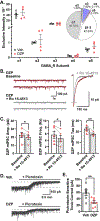Inhibitory and excitatory synaptic neuroadaptations in the diazepam tolerant brain
- PMID: 37536384
- PMCID: PMC10578451
- DOI: 10.1016/j.nbd.2023.106248
Inhibitory and excitatory synaptic neuroadaptations in the diazepam tolerant brain
Abstract
Benzodiazepine (BZ) drugs treat seizures, anxiety, insomnia, and alcohol withdrawal by potentiating γ2 subunit containing GABA type A receptors (GABAARs). BZ clinical use is hampered by tolerance and withdrawal symptoms including heightened seizure susceptibility, panic, and sleep disturbances. Here, we investigated inhibitory GABAergic and excitatory glutamatergic plasticity in mice tolerant to benzodiazepine sedation. Repeated diazepam (DZP) treatment diminished sedative effects and decreased DZP potentiation of GABAAR synaptic currents without impacting overall synaptic inhibition. While DZP did not alter γ2-GABAAR subunit composition, there was a redistribution of extrasynaptic GABAARs to synapses, resulting in higher levels of synaptic BZ-insensitive α4-containing GABAARs and a concomitant reduction in tonic inhibition. Conversely, excitatory glutamatergic synaptic transmission was increased, and NMDAR subunits were upregulated at synaptic and total protein levels. Quantitative proteomics further revealed cortex neuroadaptations of key pro-excitatory mediators and synaptic plasticity pathways highlighted by Ca2+/calmodulin-dependent protein kinase II (CAMKII), MAPK, and PKC signaling. Thus, reduced inhibitory GABAergic tone and elevated glutamatergic neurotransmission contribute to disrupted excitation/inhibition balance and reduced BZ therapeutic power with benzodiazepine tolerance.
Keywords: Benzodiazepine; GABA(A) receptor; NMDA receptor; Proteomics; Sedation; Tolerance.
Copyright © 2023 The Authors. Published by Elsevier Inc. All rights reserved.
Conflict of interest statement
Declaration of Competing Interest The authors have no disclosures and declare no conflict of interest.
Figures






Similar articles
-
Altered pharmacology of synaptic and extrasynaptic GABAA receptors on CA1 hippocampal neurons is consistent with subunit changes in a model of alcohol withdrawal and dependence.J Pharmacol Exp Ther. 2004 Sep;310(3):1234-45. doi: 10.1124/jpet.104.067983. Epub 2004 May 4. J Pharmacol Exp Ther. 2004. PMID: 15126642
-
Diazepam-induced loss of inhibitory synapses mediated by PLCδ/ Ca2+/calcineurin signalling downstream of GABAA receptors.Mol Psychiatry. 2018 Sep;23(9):1851-1867. doi: 10.1038/s41380-018-0100-y. Epub 2018 Jun 14. Mol Psychiatry. 2018. PMID: 29904150 Free PMC article.
-
Diazepam Accelerates GABAAR Synaptic Exchange and Alters Intracellular Trafficking.Front Cell Neurosci. 2019 Apr 26;13:163. doi: 10.3389/fncel.2019.00163. eCollection 2019. Front Cell Neurosci. 2019. PMID: 31080408 Free PMC article.
-
Neuroadaptive processes in GABAergic and glutamatergic systems in benzodiazepine dependence.Pharmacol Ther. 2003 May;98(2):171-95. doi: 10.1016/s0163-7258(03)00029-9. Pharmacol Ther. 2003. PMID: 12725868 Review.
-
Role of GABAA receptors in alcohol use disorders suggested by chronic intermittent ethanol (CIE) rodent model.Mol Brain. 2017 Sep 20;10(1):45. doi: 10.1186/s13041-017-0325-8. Mol Brain. 2017. PMID: 28931433 Free PMC article. Review.
Cited by
-
Chronic benzodiazepine treatment triggers gephyrin scaffold destabilization and GABAAR subsynaptic reorganization.Front Cell Neurosci. 2025 Jul 4;19:1624813. doi: 10.3389/fncel.2025.1624813. eCollection 2025. Front Cell Neurosci. 2025. PMID: 40686502 Free PMC article.
-
Comparative Analysis of the Sedative and Hypnotic Effects among Various Parts of Zizyphus spinosus Hu and Their Chemical Analysis.Pharmaceuticals (Basel). 2024 Mar 25;17(4):413. doi: 10.3390/ph17040413. Pharmaceuticals (Basel). 2024. PMID: 38675375 Free PMC article.
References
Publication types
MeSH terms
Substances
Grants and funding
LinkOut - more resources
Full Text Sources
Medical
Molecular Biology Databases
Miscellaneous

